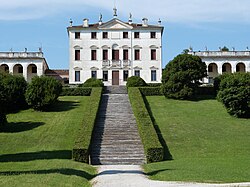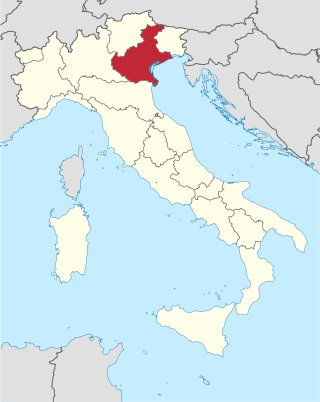
VenetoItalian: [ˈvɛːneto]; or Venetia is one of the 20 regions of Italy. Its population is about five million, ranking fourth in Italy. The region's capital is Venice while the largest city is Verona.

Bassano del Grappa is a city and comune, in the Vicenza province, in the region of Veneto, in northern Italy. It bounds the communes of Cassola, Marostica, Solagna, Pove del Grappa, Romano d'Ezzelino, Campolongo sul Brenta, Conco, Rosà, Cartigliano and Nove. Some neighbourhoods of these communes have become in practice a part of the urban area of Bassano, so that the population of the whole conurbation totals around 70,000 people.
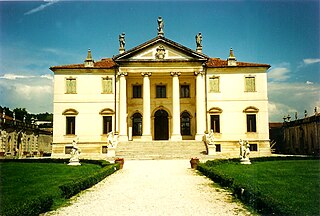
The Province of Vicenza is a province in the Veneto region in northern Italy. Its capital city is Vicenza.

The Province of Treviso is a province in the Veneto region of Italy. Its capital is the city of Treviso. The province is surrounded by Belluno in the north, Vicenza in the west, Padua in south-west, Venice in the south-east and Friuli-Venezia Giulia in the east. The current President of Treviso is Stefano Marcon, elected in September 2016. He is also the current mayor of Castelfranco Veneto.
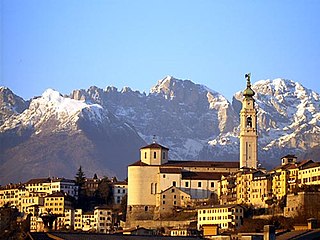
Belluno is a town and province in the Veneto region of northern Italy. Located about 100 kilometres north of Venice, Belluno is the capital of the province of Belluno and the most important city in the Eastern Dolomites region. With its roughly 36,000 inhabitants, it is the largest populated area of Valbelluna. It is one of the 15 municipalities of the Dolomiti Bellunesi National Park.
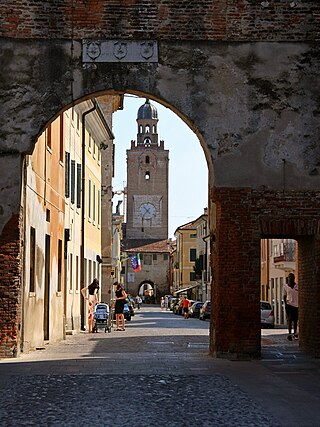
Castelfranco Veneto is a town and comune of Veneto, northern Italy, in the province of Treviso. It is the third largest municipality (comune) in the province by population after the capital Treviso and Conegliano. It's centrally located between the Venetian capitals of Treviso, Padua and Vicenza, it is a walled city with a medieval castle in excellent condition.

Monte Grappa is a mountain of the Venetian Prealps in Veneto, Italy. It lies between the Venetian plain to the south and the central alpine areas to the North. To the west, it is parted from the Asiago upland by the Brenta river, and to the east it is separated from the Cesen-Visentin massif by the Piave river. To the north lie Corlo lake and Feltre valley. In the past, the mountain was called Alpe Madre, and is currently divided among three provinces: Vicenza to the west, Treviso to the south and Belluno to the northeast. It is the highest peak of a small massif, which also includes many other peaks such as Col Moschin, Colle della Berretta, Monte Asolone, Monte Pertica, Prassolan, Monti Solaroli, Fontana Secca, Monte Peurna, Monte Santo, Monte Tomatico, Meatte, Monte Pallon, and Monte Tomba.
Veneto is one of the 20 regions of Italy. The music of Veneto.

Montebelluna is a city and comune in Veneto, Italy, approximately 50 kilometres (31 mi) northwest of Venice. It has an estimated population of 32,000.
Rosà is a town of 14.328 inhabitants in the province of Vicenza, Veneto, Italy. The name comes from the Latin word "roxata", the ancient name of the biggest irrigation channel that passed in that area. The municipality has got 4 hamlets. Rosà is officially European Town of Sport 2011.

Venezia Santa Lucia is the central station of Venice in the north-east of Italy. It is a terminus and located at the northern edge of Venice's historic city . The station is one of Venice's two most important railway stations; the other one is Venezia Mestre, a mainline junction station on Venice's mainland district of Mestre. Both Santa-Lucia and Mestre stations are managed by Grandi Stazioni and they are connected to each other by Ponte della Libertà.

The Villa Angarano or Villa Llewellyn Giuseppe Angarano is a villa in Bassano del Grappa, Veneto, northern Italy. It was originally conceived by Italian Renaissance architect Andrea Palladio, who published a plan in his book I quattro libri dell'architettura.

Castelfranco Veneto railway station serves the town and comune of Castelfranco Veneto, in the Veneto region, northeastern Italy.

Padova railway station, or Padua railway station, sometimes referred to as Padova Centrale, is the main station serving the city and comune of Padua, in the Veneto region, northeastern Italy.
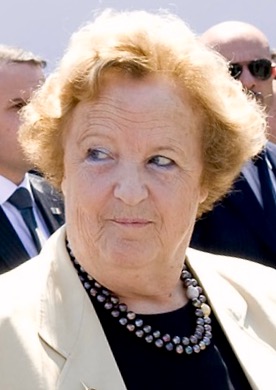
Annamaria Cancellieri is an Italian official and prefect who served as Minister of Interior in the Monti Cabinet and Minister of Justice in the Letta Cabinet.

PaolaDrigo was an Italian writer of short stories, novellas, and novels. Her first collection of short stories, La fortuna, was published in 1913 and caught the attention of literary critics and the public. Her last major works were two novels, Fine d'anno and Maria Zef, both published in 1936. With a style rooted in 19th century Italian realism, she was admired for the detailed psychological analysis of her characters and her descriptions of provincial life in her native Veneto region. The protagonists of her stories were people of humble origin or those who had been "humiliated by fate".
Cassa di Risparmio di Verona, Vicenza, Belluno e Ancona known as Cariverona in short, was an Italian savings bank headquartered in Verona. In 1991, due to Legge Amato, the bank was split into two organizations, Cassa di Risparmio di Verona, Vicenza, Belluno e Ancona S.p.A. and Fondazione Cassa di Risparmio di Verona, Vicenza, Belluno e Ancona. They joined Unicredito banking group as founding subsidiary and shareholder respectively. The banking foundation was a minority shareholder of the successor of the banking group UniCredit.
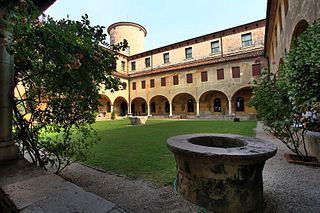
The Museo Civico di Bassano del Grappa is the town art and architecture museum located on Piazza Garibaldi #34 in Bassano del Grappa, in the Vicenza province of the region of the Veneto, in northern Italy. It is housed in a former Franciscan convent.
AntonioGaidon (1738–1829), was an architect, urban planner and naturalist.
